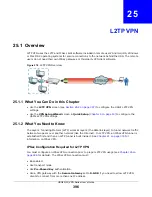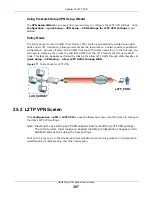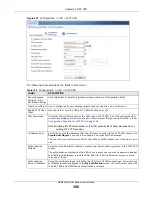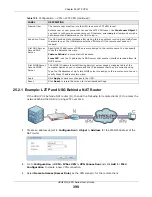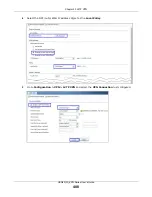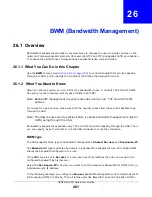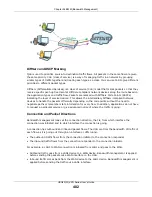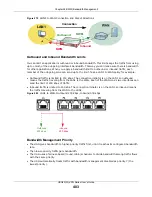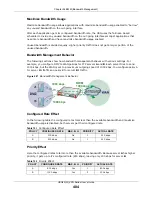
Chapter 26 BWM (Bandwidth Management)
USG20(W)-VPN Series User’s Guide
407
26.2.1 The Bandwidth Management Add/Edit Screen
The
Configuration > Bandwidth Management Add/Edit
screen allows you to create a new
condition or edit an existing one.
DSCP Code
These are the DSCP code point values of incoming and outgoing packets to which this
policy applies. The lower the number the higher the priority with the exception of 0
which is usually given only best-effort treatment.
any
means all DSCP value or no DSCP marker.
default
means traffic with a DSCP value of 0. This is usually best effort traffic
The “
af
” options stand for Assured Forwarding. The number following the “
af
”
identifies one of four classes and one of three drop preferences.
Service Type
App
and the service name displays if you selected
Application Object
for the
service type. An
Application Object
is a pre-defined service.
Obj
and the service name displays if you selected
Service Object
for the service
type. A
Service Object
is a customized pre-defined service or another service.
Mouse over the service object name to view the corresponding IP protocol number.
BWM In/Pri/Out/Pri
This field shows the amount of bandwidth the traffic can use.
In
- This is how much inbound bandwidth, in kilobits per second, this policy allows
the matching traffic to use. Inbound refers to the traffic the USG sends to a
connection’s initiator. If
no
displays here, this policy does not apply bandwidth
management for the inbound traffic.
Out
- This is how much outgoing bandwidth, in kilobits per second, this policy allows
the matching traffic to use. Outbound refers to the traffic the USG sends out from a
connection’s initiator. If
no
displays here, this policy does not apply bandwidth
management for the outbound traffic.
Pri
- This is the priority for the incoming (the first
Pri
value) or outgoing (the second
Pri
value) traffic that matches this policy. The smaller the number, the higher the
priority. Traffic with a higher priority is given bandwidth before traffic with a lower
priority. The USG ignores this number if the incoming and outgoing limits are both
set to 0. In this case the traffic is automatically treated as being set to the lowest
priority (7) regardless of this field’s configuration.
DSCP Marking
This is how the USG handles the DSCP value of the incoming and outgoing packets
that match this policy.
In
- Inbound, the traffic the USG sends to a connection’s initiator.
Out
- Outbound, the traffic the USG sends out from a connection’s initiator.
If this field displays a DSCP value, the USG applies that DSCP value to the route’s
outgoing packets.
preserve
means the USG does not modify the DSCP value of the route’s outgoing
packets.
default
means the USG sets the DSCP value of the route’s outgoing packets to 0.
The “
af
” choices stand for Assured Forwarding. The number following the “
af
”
identifies one of four classes and one of three drop preferences.
Apply
Click
Apply
to save your changes back to the USG.
Reset
Click
Reset
to return the screen to its last-saved settings.
Table 155
Configuration > Bandwidth Management
LABEL
DESCRIPTION
Summary of Contents for ZyWall USG20-VPN
Page 17: ...17 PART I User s Guide ...
Page 18: ...18 ...
Page 99: ...99 PART II Technical Reference ...
Page 100: ...100 ...




